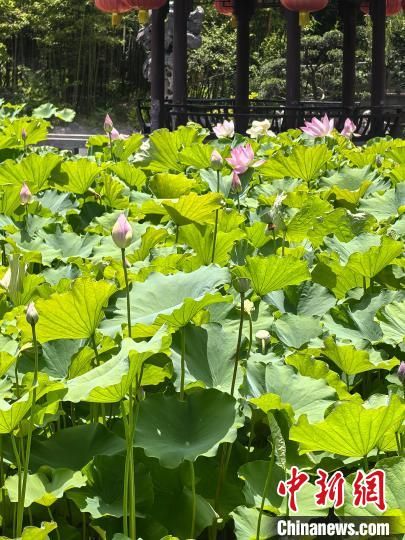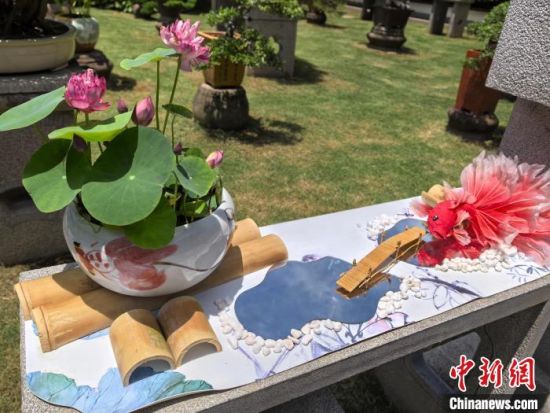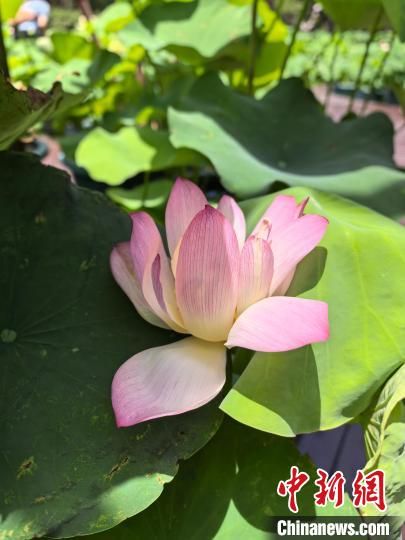In the midst of summer, Shanghai’s lotus blossoms bring vibrant scenery, inspiring new energy in cultural tourism.
As Shanghai emerges from the rainy season, the summer heat sets in, marking the perfect time to admire lotus flowers. With the 12th Shanghai Lotus and Water Lily Exhibition about to open, visitors can explore the ancient Guyi Garden, one of Shanghai’s five classical gardens. Upon entering, lotuses appear to “grow” from scrolls—their stems upright, leaves like umbrellas, and petals elegantly unfurling, creating a poetic contrast with the artwork.
Among over a thousand pots of rare and exquisite lotuses from around the world, “Dreaming of Yi Lotus” blooms quietly. This variety, the first from Guyi Garden registered with the International Water Lily and Water Gardening Society (IWGS), changes color daily—starting deep pink, fading to light pink, and finally revealing yellow-white interiors with red-tipped petals. It won an award at the 38th National Lotus Exhibition in 2024.
The exhibition spans 6,100 square meters, featuring over 500 varieties of lotus (2,000 pots) and 150 varieties of water lilies (320 pots). Ten lotus varieties, including “Dreaming of Yi Lotus,” “Red Tribute,” and “Morning Sunlight on Maple Dew,” debut in Shanghai, along with eight water lily varieties like “Glazed Glass,” “Magic Brocade,” and “Bangkok Pink Panther.”
Traditional Chinese-themed installations blend seamlessly with nature, incorporating elements like folding screens, scrolls, and round fans. At the Moon-Viewing Terrace, a massive 3-meter-wide fan-shaped floral frame, inspired by classical ladies’ fans, stands before a tranquil pond of blooming lotuses. The delicate fragrance and antique charm create a picturesque scene, transporting visitors into an ancient painting. In the bowl lotus section, elegant blooms mingle with animated IP designs for a unique ambiance.

This year’s exhibition, themed “Lotus in Full Splendor, Harmony in Coexistence,” features Guyi Garden as the main venue, with four sub-venues and two promotional sites across Jing’an, Yangpu, Pudong, Jiading, and Songjiang districts. The water lily section showcases tropical and hardy varieties, with night-blooming lilies complementing the summer starry sky.
Spanning three solar terms—Minor Heat, Major Heat, and Autumn Begins—the exhibition extends to Shanghai Expo Culture Park, a sub-venue with over 4,000 square meters of pond-grown lotuses. Shenyuan displays more than 40 varieties, including 800 square meters of pond lotuses and 300 potted specimens.
Notable varieties include “China Red·Shanghai,” bred for the 2010 Shanghai Expo opening ceremony, matching the iconic red of the China Art Museum (former China Pavilion). “Universal Love Lotus,” a new breed from Chenshan Botanical Garden, honors Sun Yat-sen alongside other commemorative varieties. “Galaxy,” with its deep-to-light blue gradient petals dotted with star-like white speckles, won second place in the 2016 International Water Lily Competition.

At sub-venue Zuibai Pool Park, the theme “Poetry and Painting for the Lotus” merges pond landscapes with an exhibition on artist Dong Qichang. Zhabei Park harmonizes “Lotus + Art” with musical flash mobs and a lotus market, while Huangxing Park’s “Starry Lotus Journey” night market blends light displays, creative cuisine, and cultural products.
For the first time, the exhibition includes a corporate section, showcasing premium lotus varieties from renowned growers, offering visitors purchase opportunities and businesses a sales platform.
Additionally, lotus and water lily displays have expanded to shopping malls and ancient towns, bringing the beauty of lotus ponds to urban spaces.






